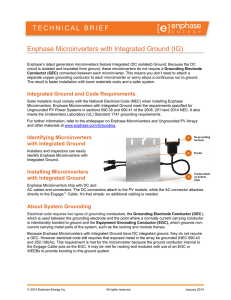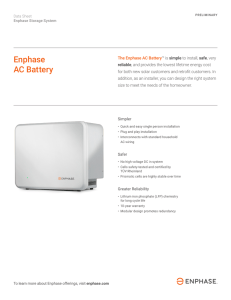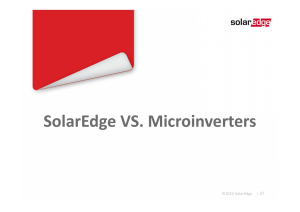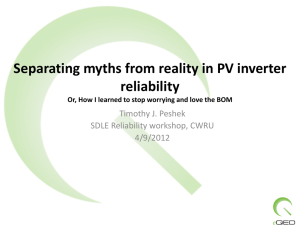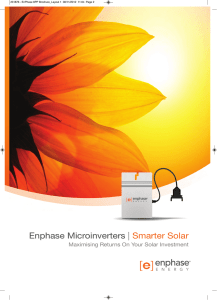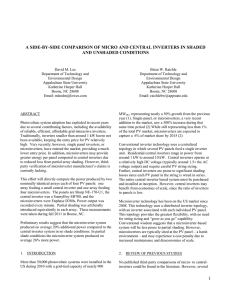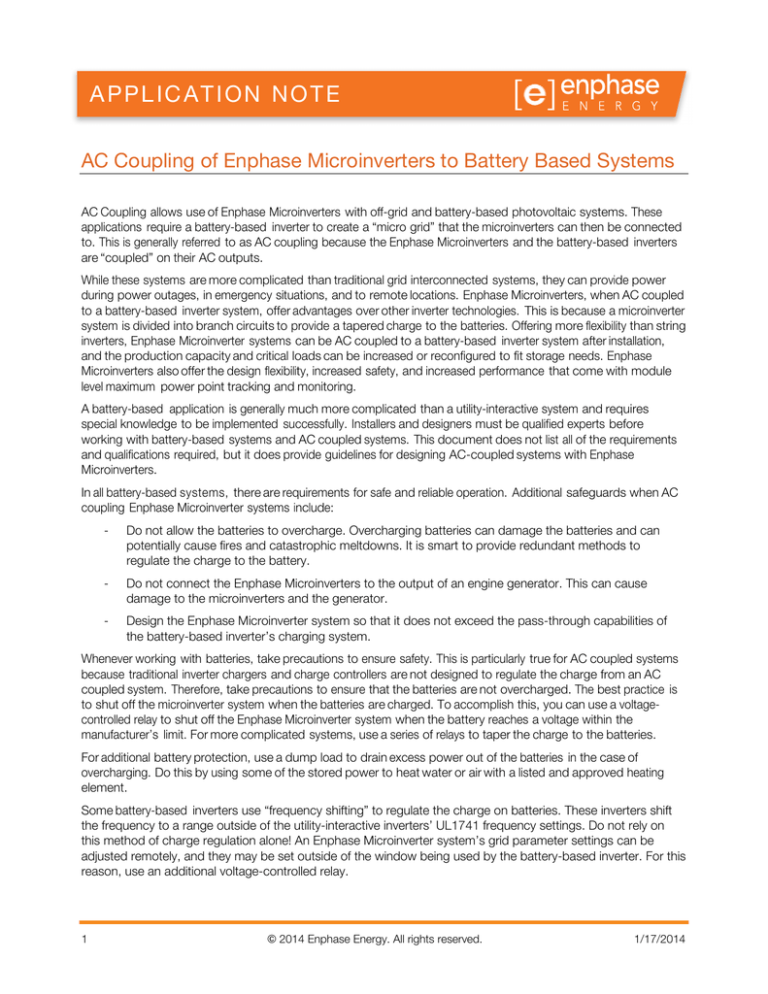
APPLICATION NOTE
AC Coupling of Enphase Microinverters to Battery Based Systems
AC Coupling allows use of Enphase Microinverters with off-grid and battery-based photovoltaic systems. These
applications require a battery-based inverter to create a “micro grid” that the microinverters can then be connected
to. This is generally referred to as AC coupling because the Enphase Microinverters and the battery-based inverters
are “coupled” on their AC outputs.
While these systems are more complicated than traditional grid interconnected systems, they can provide power
during power outages, in emergency situations, and to remote locations. Enphase Microinverters, when AC coupled
to a battery-based inverter system, offer advantages over other inverter technologies. This is because a microinverter
system is divided into branch circuits to provide a tapered charge to the batteries. Offering more flexibility than string
inverters, Enphase Microinverter systems can be AC coupled to a battery-based inverter system after installation,
and the production capacity and critical loads can be increased or reconfigured to fit storage needs. Enphase
Microinverters also offer the design flexibility, increased safety, and increased performance that come with module
level maximum power point tracking and monitoring.
A battery-based application is generally much more complicated than a utility-interactive system and requires
special knowledge to be implemented successfully. Installers and designers must be qualified experts before
working with battery-based systems and AC coupled systems. This document does not list all of the requirements
and qualifications required, but it does provide guidelines for designing AC-coupled systems with Enphase
Microinverters.
In all battery-based systems, there are requirements for safe and reliable operation. Additional safeguards when AC
coupling Enphase Microinverter systems include:
-
Do not allow the batteries to overcharge. Overcharging batteries can damage the batteries and can
potentially cause fires and catastrophic meltdowns. It is smart to provide redundant methods to
regulate the charge to the battery.
-
Do not connect the Enphase Microinverters to the output of an engine generator. This can cause
damage to the microinverters and the generator.
-
Design the Enphase Microinverter system so that it does not exceed the pass-through capabilities of
the battery-based inverter’s charging system.
Whenever working with batteries, take precautions to ensure safety. This is particularly true for AC coupled systems
because traditional inverter chargers and charge controllers are not designed to regulate the charge from an AC
coupled system. Therefore, take precautions to ensure that the batteries are not overcharged. The best practice is
to shut off the microinverter system when the batteries are charged. To accomplish this, you can use a voltagecontrolled relay to shut off the Enphase Microinverter system when the battery reaches a voltage within the
manufacturer’s limit. For more complicated systems, use a series of relays to taper the charge to the batteries.
For additional battery protection, use a dump load to drain excess power out of the batteries in the case of
overcharging. Do this by using some of the stored power to heat water or air with a listed and approved heating
element.
Some battery-based inverters use “frequency shifting” to regulate the charge on batteries. These inverters shift
the frequency to a range outside of the utility-interactive inverters’ UL1741 frequency settings. Do not rely on
this method of charge regulation alone! An Enphase Microinverter system’s grid parameter settings can be
adjusted remotely, and they may be set outside of the window being used by the battery-based inverter. For this
reason, use an additional voltage-controlled relay.
1
© 2014 Enphase Energy. All rights reserved.
1/17/2014
AC Coupled Applications
If an engine generator is present, do not connect the Enphase Microinverters to the same load panel as the
generator. When using a generator to charge batteries in a battery-based inverter system, the battery-based inverter
also internally bypasses the generator’s output to the back-up / emergency load panel that the Enphase
microinverters are feeding. Allowing this connection can damage the generator and microinverters. Therefore, if
using a generator to charge batteries, ensure that the Enphase Microinverters are shut-off when the generator is
running. The best method is to use a voltage controlled relay that is activated by the generator panel. Use a transfer
switch to ensure that the generator is always isolated from the Enphase Microinverters.
Diagram 1: Grid-Tied AC Coupled System
Envoy
Communications
Gateway
Battery
Inverter
Subpanel
Critical Loads
Main Service
Panel
Electric Grid
Battery Bank
Single Module
DC
Microinverters &
AC Electrical
Diagram 2: Off-Grid AC Coupled System
Relay turns off Enphase
microinverters if generator is running
Envoy
Communications
Gateway
Battery
Inverter
Subpanel
Critical Loads
Generator Panel
Generator
Battery Bank
Single Module
DC
2
Microinverters &
AC Electrical
© 2014 Enphase Energy
1/17/2014
AC Coupled Applications
Diagram 3: Microgrid
Generator
Battery Inverter
Battery Bank
Other DC Renewable
Energy Sources
Solar Modules,
Microinverters &
AC Electrical
The Power Room of an AC Coupled System with Enphase Microinverters, Courtesy of Magnum
Energy
3
© 2014 Enphase Energy
1/17/2014
AC Coupled Applications
For additional resources on installing AC-Coupled systems, refer to the battery manufacturer’s and battery- based
inverter manufacturer’s documentation. Enphase Microinverters work with a number of battery-based inverter
manufacturers and component manufacturers, including Magnum Energy, Outback Power Systems, MidNite Solar,
SMA, and Schneider Electric. You can find many other documents, application notes, and schematics on AC
Coupling at the following websites.
Magnum Energy
http://www.magnumenergy.com/Documents/DocsFront.htm
Outback Power Systems
http://www.outbackpower.com/index.php/applications/ac-coupling
MidNite Solar
http://www.midnitesolar.com/index.php
Disclaimers
No Guaranty as to Content of Information - The information in this application note is provided for
general information purposes only and may not apply to a specific or particular situation or circumstance. While
Enphase has made reasonable efforts to ensure that the information is accurate at the time of publication,
information is constantly evolving and the information provided does not purport to be correct, comprehensive
or exhaustive. Enphase expressly disclaims any liability for any errors or omissions in any information published.
Information Provided “As-Is” - The information contained in this application note is provided “AS-IS” and
any representations do not constitute an express or implied warranty of any kind. Enphase makes no
representations as to the completeness or validity of any information contained herein or the consequences
arising from the use of or reliance on this information, and Enphase expressly and specifically disclaims all
warranties, whether express or implied, written or oral, including, without limitation, the warranty of
merchantability and the warranty of fitness for a particular purpose, provided, however, that nothing contained
herein is intended to alter or revise limited warranties, if any, provided to purchasers of Enphase
products or services at the time of purchase.
Disclaimer of Liability - By accessing this application note, you acknowledge that you are accessing the
information contained therein at YOUR OWN RISK and in your own discretion. Enphase disclaims all liability and
shall not be liable to you for any damages to your person or property which may result from your use of this
application note.
Under no circumstances shall Enphase be liable for any claim arising from the use or misuse of this application
note or any reliance on any information contained herein, including without limitation any claims for direct,
indirect, incidental, consequential, special, exemplary or punitive damages, as well as attorney’s fees or costs,
regardless of whether such claims arise out of negligence, gross negligence, carelessness, recklessness,
wantonness, fraud, misrepresentation or contract. This disclaimer of liability also extends and includes any
alleged damages incurred by user as a result of linking to a third party’s website.
Links to Third Party Sites - This application note contains links to sites controlled and/or operated by a third
party over which Enphase has no control. Enphase is not responsible for the contents of any linked site. Any link
is provided only as a convenience and is not an endorsement by Enphase of the contents of any third party site
or any product or service described on such site.
4
© 2014 Enphase Energy
1/17/2014

